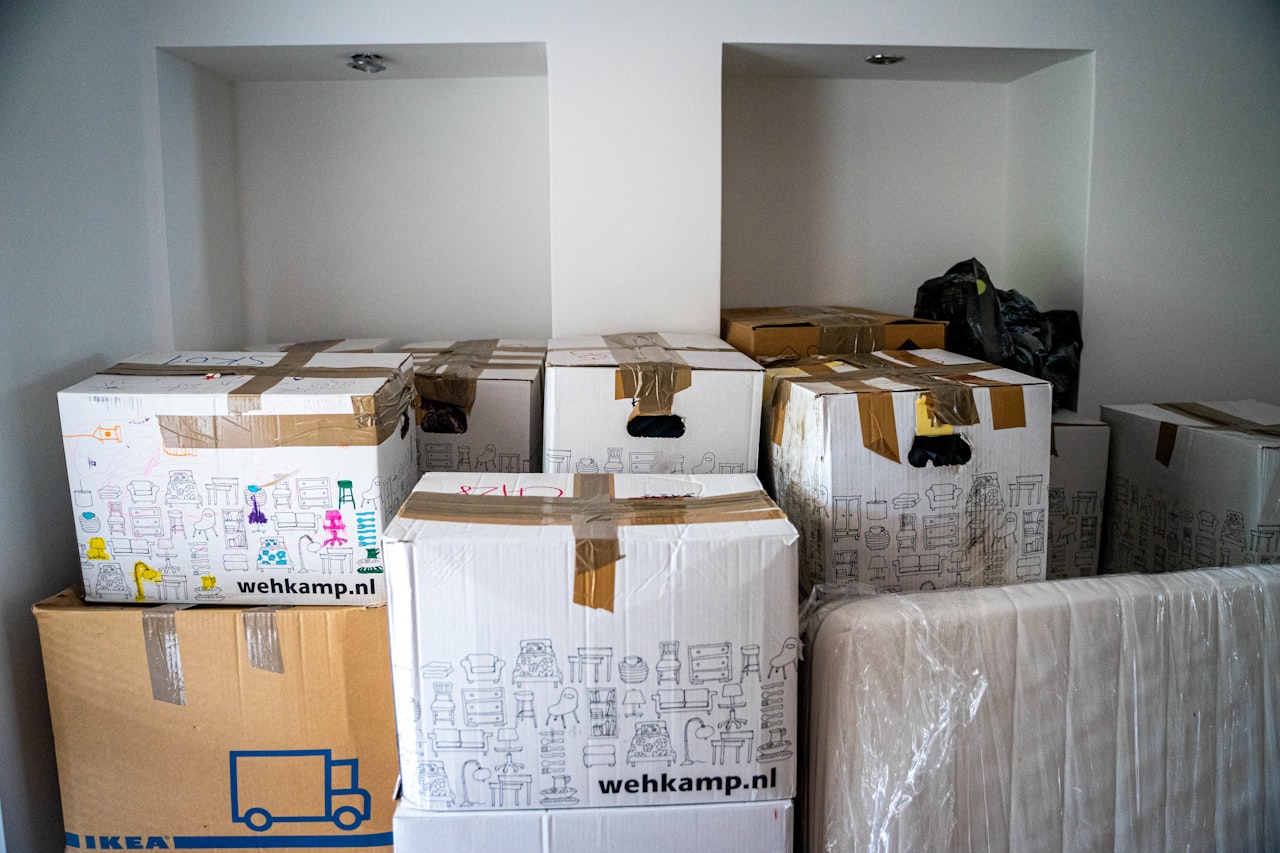11 packing tips for a less stressful move: Start early and stay organized
Real Estate

Real Estate

Effective packing is key to a successful move, and you can achieve this through proper planning and organization. Some of the best packing tips for moving include getting started early, using your items as packing materials and keeping itemized lists of your boxes to track what you packed and where it goes. This guide explores all the packing tips you need to help you streamline your move, save money and reduce stress.
Creating a moving schedule can ease the stress and chaos of relocating your home and family. I recommend starting the process six to eight weeks ahead and allocating specific tasks for each week leading up to the move.
To create an effective moving schedule, set your move-in date and then work backward by doing the following:
Following this schedule can minimize last-minute chaos and maintain control throughout the moving process.
Creating a dedicated folder for all important moving information is a smart way to stay organized throughout the relocation process. This folder can be a central hub for all essential documents and details related to your move. You can include your moving checklist, contact information for your moving company, a copy of your lease or closing documents for your new home, and your moving schedule.
Additionally, store any receipts, estimates and contracts related to the move in this folder. Having all these documents in one place ensures easy access and minimizes the risk of forgetting or misplacing vital information during the hectic moving process.
Creating a detailed home inventory is an invaluable step that can save you money and time when preparing for your move. Making a list of each room’s contents will help you decide what you need to pack and what can be thrown away or donated.
To do this effectively, create separate inventory lists for each room in your home. As you go through each room, note items you plan to purge, such as those you want to donate or sell and things you intend to pack.
Making an inventory for each room will keep you from feeling overwhelmed as you pack. It can also help keep track of what you unpack after you move.
Purging unnecessary items before your move will make the process more efficient and less overwhelming. It’s an opportunity to declutter and reduce the amount of stuff you have to pack, which can save you time, money and space in your new home. Consider purging items you haven’t used in a significant amount of time, like clothes that no longer fit, kitchen appliances that rarely get used and anything you have multiples of.
Once you’ve gone through all your stuff, consider donating items in good condition to charities or local organizations. You can also have a garage sale or sell items online to make extra cash for your move.
When I have clients planning a cross-country move, I encourage them to part with inexpensive or easily replaceable items. Moving costs are often based on weight, so the fewer items they have to move, the lower their moving costs will be.
Finding affordable or free moving boxes is a savvy way to reduce moving costs. Check out options like Facebook Marketplace or local online classified ads where people give away or sell their used moving boxes at a fraction of the cost of new ones. You can also visit local grocery stores, liquor stores or package stores to see if they have extra boxes they’re willing to give away.
When looking for boxes, it’s essential to consider the types you’ll need for the items you need to pack. Opt for small boxes for heavy items such as books or paper goods to ensure they won’t get too heavy. For fragile items like ceramics and kitchenware, invest in double-walled boxes, commonly known as dish barrels, which offer extra protection during the move.
Remember that your boxes will be stacked in the moving truck, so make sure not to overpack them and use padding on the top and bottom of each box to prevent damage during transport.
When packing your boxes, maximizing space and protecting your breakable items from damage is essential.
One efficient packing strategy is to nest smaller items within larger ones. You can use baskets, pots and pans as containers for smaller kitchen or household items. Not only does this save space, but it also protects your items within the sturdy confines of these containers.
Another cost-effective and eco-friendly approach is to use your clothing, towels, pillows, linens and any other soft materials to wrap and pad fragile items like glassware, dishes, ceramic items, framed art and electronics. This packing method helps you make the most of your available space and ensures that your fragile items arrive at your new house undamaged.
Labeling your moving boxes is crucial in making the unpacking process efficient and organized. You can even take it a step further and color code your boxes.
When packing your boxes, label each box with the specific room its contents came from. This way, your movers will know where to place each box in your new home, which saves you some physical labor when it’s time to unpack.
Next, write a detailed description of the box’s contents. For instance, in addition to labeling a box as “kitchen,” you can specify “pots and pans,” “utensils” or “junk drawer.” This specific information will help you prioritize which boxes to unpack first.
You should also label boxes containing fragile items with the word “fragile” or designate them with fragile stickers. A fragile label alerts movers to handle these boxes with extra care and not to stack heavy boxes on top of them in the moving truck.
Taking pictures of your electronics before disassembly can save you time and frustration during a move. For instance, snapping photos of the cables and connections on the back of your TV, computer or home entertainment system helps you reconnect them correctly in your new home. When it’s time to reassemble, these photos serve as visual guides.
A photo folder on your smartphone dedicated to moving-related images is a great idea for keeping all these crucial visuals easily accessible.
Additionally, I always recommend that my clients unplug any chargers for phones or tablets right before the move and put them in a designated box. This way, all the essential chargers are in one place when they get to their new home instead of being buried in several boxes around the house.
Packing a first-night bag like a suitcase for a weekend getaway is a great moving strategy. This way, you have your essential items readily available for that first night in your new place without digging through boxes.
Your first-night bag can include a change of clothes, toiletries, medications, important documents and any personal items you’ll need for the first day or two.
Additionally, consider a second suitcase or box with sheets, towels, a shower curtain, soap, toilet paper, paper towels and basic cleaning supplies. These essentials will make your first night and morning in your new home more comfortable, and you won’t have to dig through several boxes to find them.
As moving day approaches, using up perishable foods to prepare your fridge for cleaning is essential.
Start by taking inventory of your pantry, fridge and freezer. Plan your meals in the days leading up to the move, focusing on using up perishable items and pantry staples. Get creative with recipes incorporating multiple ingredients to ensure nothing goes to waste.
Consider donating unopened, nonperishable items to local food banks or shelters. Many organizations accept canned goods, pasta, rice and other nonperishable items. When donating, make sure to check the expiration dates and only donate items that are within their use-by dates.
The night before your move, unplug the fridge and prop open the doors to allow the freezer to defrost overnight. In the morning, clean the fridge’s interior with a food-safe cleaning product and then plug it back in so it’s ready for the next renters or owners.
Finishing most of your packing well in advance is a smart strategy to reduce stress on moving day. When you finish early, you can feel calm and confident, which allows you to focus on overseeing the move.
Remember that professional movers often charge extra for packing supplies or boxing up random items on moving day. Having everything packed and organized beforehand can avoid unnecessary charges and ensure a smoother, more efficient moving experience.
Using these moving tips can significantly reduce the stress associated with moving. Starting early and following a schedule can make the transition to your new home easy and organized.
If you feel like you’re unable to handle packing, don’t have enough time, or prefer to delegate the task, many moving companies offer professional packing services. You can easily arrange these services to simplify the process and ensure a seamless move.
Start Your New Home Search Now!
Stay up to date on the latest real estate trends.

Atlanta
Navigating the Path Forward After a Challenging Sale Journey

Atlanta Lifestyle
Transforming Workspaces with Style and Functionality

Real Estate
Transforming Vacant Spaces into Dream Homes for Buyers

Atlanta Lifestyle
Crafting Community, One Bagel at a Time
You’ve got questions, and we can’t wait to answer them.